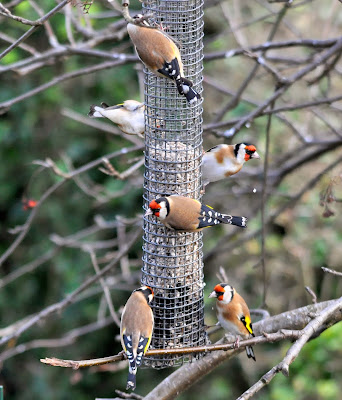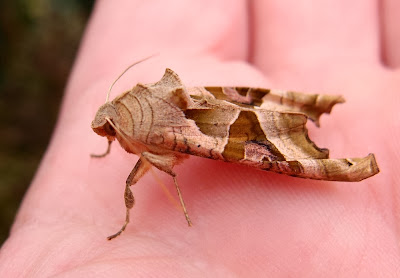The weather was miserable this morning so I used the time to input the last of the year's ringing data on the computer. After lunch the weather picked up a bit so I took the dogs for their last walk of 2013. There wasn't much bird life to be seen on the nearby farmland not that the dogs were bothered about that. Having said that I did think I heard a distant Waxwing at one point but I dismissed it as wishful thinking. However, I bumped into a friend after and he had seen 5 Waxwings not far away a few days previously so I may not have been hearing things after all. I have been putting a few apples out in the garden on the off chance so I am prepared; not that a repeat of last winter is likely as there are so few in the country.
The wind had dropped off almost completely by the time I got home which wasn't forecast so I put a net up in the garden for the remaining twenty minutes or so of good daylight in 2013. This resulted in a catch of 2 new Siskins and 3 retrap Goldfinches with one of the Goldfinches being a retrap from last year. Only 2 new birds but they were only the 2nd and 3rd Siskin to be ringed in the garden this winter.
 |
| Adult male Siskin and the 1020th bird ringed in the garden in 2013. |
 |
| Tail of known adult Goldfinch D130175 and last bird caught in the garden in 2013. At some point I will post some of my findings on ageing and sexing these birds. |
This small catch brought the total number of birds ringed in the garden in 2013 to 1021. This is by far the highest total ever for the garden. Now there are probably quite a few gardens in the country that can boast larger ringing totals than that but then mine won't take a net larger than 18ft long in any direction so it is a great total given its size.
Ringing totals for my garden in 2013:
Sparrowhawk 1Woodpigeon 1
Collared Dove 7
Waxwing 256
Wren 3
Dunnock 11
Robin 6
Blackbird 15
Fieldfare 2
Blackcap 18
Goldcrest 3
Long-tailed Tit 7
Willow Tit 1
Coal Tit 10
Blue Tit 31
Great Tit 14
Starling 43
House Sparrow 5
Chaffinch 12
Greenfinch 44
Goldfinch 416
Siskin 105
Total 1021
The one species total that you should pick out of all these is that of House Sparrow as they make up just under 0.5% of the birds caught in the garden with a meagre total of just 5. Now how sad is that. It just shows how much they have declined and are struggling. Lets hope all our wildlife fares better in 2014.



















































